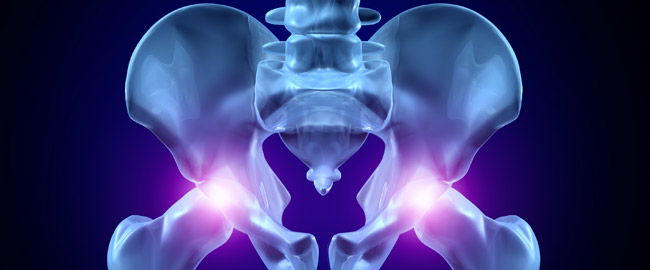Minimally invasive hip replacement involves more than just a shorter incision. Modern minimally invasive techniques also focus on the way surgeons gain access to the hip joint. The goal is to minimize muscle and tendon disruption, making surgery less traumatic for patients, allowing for shorter hospital stays and quicker recoveries.
ASI Hip Technique

-
The Hip
The hip is a ball-and-socket joint that allows the leg to move in a variety of positions. The femoral head (ball) rides in the acetabulum (socket). The joint is lined with a lubricating tissue called cartilage, which cushions the joint as it moves and bears weight.
Osteoarthritis, the most common form of arthritis, is a wear and tear condition that destroys joint cartilage. It typically develops after years of constant motion and pressure in the joints. As the cartilage wears away, the joint becomes increasingly painful and difficult to move. Unfortunately, cartilage does not have the ability to repair or replace itself like other tissues in the body. If conservative treatment options fail to provide relief, your surgeon may recommend total hip replacement.
-
Traditional Total Hip Replacement
Traditional total hip replacement (THR) uses an incision located on the side, or toward the back, of the hip. The incision requires surgeons to cut through muscles and ten- dons, which need time to heal. During the healing process, patients are typically prescribed extensive physical therapy to regain strength and stability in the joint.
-
Anterior Supine Intermuscular (ASI) Hip Replacement
Unlike traditional minimally invasive hip replacement techniques, the ASI technique uses an incision at the front of the hip instead of the side or back of the hip. This modified incision placement allows surgeons to directly approach the hip joint by going between the muscles that surround the hip joint. Traditional approaches would require cutting the muscles and/or tendons that surround the hip.
The ASI minimally invasive hip replacement procedure is designed to reduce the trauma to the tissues surrounding the hip joint. By preserving the muscles and tendons, surgeons may enable their patients to walk the day of surgery, to experience less postoperative pain, and to return to daily activities more quickly.
-
How is the Biomet® ASI Technique Unique?
Biomet worked with leading surgeons to develop unique instrumentation to make the ASI approach reproducible for other surgeons. Similar techniques require a special, costly operating fracture table. The ASI technique can be performed on either this special fracture table or on a traditional operating room table.
Hundreds of thousands of people undergo total hip replacement every year in the United States. Many patients are not candidates for other minimally invasive hip surgery techniques due to obesity or other considerations. The ASI technique has the advantage of potentially offering a minimally invasive option for patients who would not otherwise be considered for other minimally invasive approaches.
-
Bone Conserving Implants
In addition to the minimally invasive ASI technique, Biomet also offers bone-conserving implant options. The Taperloc® MicroplastyTM S
tem features reduced stem lengths, making its bone conserving, tissue-sparing design an excellent option for use with the ASI technique. The Taperloc® Micro- plastyTM stem also provides an alternative to hip resurfacing.
-
After Surgery
Patients are generally hospitalized for two to three days after surgery. During this time, they receive pain medication and begin physical therapy. Physical therapy promotes blood flow to help the hip regain motion and to facilitate a Rapid Recovery. Patients should be able to perform these exercises on their own at home. It is important to continue with exercises as the surgeon has instructed after the return home.
